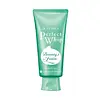What's inside
What's inside
 Key Ingredients
Key Ingredients

 Benefits
Benefits

 Concerns
Concerns

 Ingredients Side-by-side
Ingredients Side-by-side

Water
Skin ConditioningStearic Acid
CleansingPalmitic Acid
EmollientMyristic Acid
CleansingCocamidopropyl Betaine
CleansingPotassium Hydroxide
BufferingCocamide DEA
EmulsifyingPropylene Glycol
HumectantHydroxyethylcellulose
Emulsion StabilisingMelaleuca Alternifolia Leaf Oil
AntioxidantDisodium EDTA
Ethylhexylglycerin
Skin ConditioningPhenoxyethanol
Preservative3-O-Ethyl Ascorbic Acid
Skin ConditioningCaprylhydroxamic Acid
Hamamelis Virginiana Extract
AntiseborrhoeicCentella Asiatica Extract
CleansingWater, Stearic Acid, Palmitic Acid, Myristic Acid, Cocamidopropyl Betaine, Potassium Hydroxide, Cocamide DEA, Propylene Glycol, Hydroxyethylcellulose, Melaleuca Alternifolia Leaf Oil, Disodium EDTA, Ethylhexylglycerin, Phenoxyethanol, 3-O-Ethyl Ascorbic Acid, Caprylhydroxamic Acid, Hamamelis Virginiana Extract, Centella Asiatica Extract
Water
Skin ConditioningStearic Acid
CleansingMyristic Acid
CleansingPEG-8
HumectantPotassium Hydroxide
BufferingLauric Acid
CleansingGlycerin
HumectantDipropylene Glycol
HumectantBeeswax
Emulsion StabilisingPolyquaternium-7
PEG-90m
Emulsion StabilisingPEG/PPG-14/7 Dimethyl Ether
Skin ConditioningSodium Hyaluronate
HumectantSericin
Skin ConditioningSodium Acetylated Hyaluronate
HumectantChamomilla Recutita Flower Extract
MaskingAlcohol
AntimicrobialSalicylic Acid
MaskingDisodium EDTA
Sodium Metabisulfite
AntioxidantButylene Glycol
HumectantCitric Acid
BufferingPotassium Sorbate
PreservativeSilica
AbrasiveBHT
AntioxidantSodium Benzoate
MaskingParfum
MaskingCI 17200
Cosmetic ColorantCI 15985
Cosmetic ColorantCI 61570
Cosmetic ColorantWater, Stearic Acid, Myristic Acid, PEG-8, Potassium Hydroxide, Lauric Acid, Glycerin, Dipropylene Glycol, Beeswax, Polyquaternium-7, PEG-90m, PEG/PPG-14/7 Dimethyl Ether, Sodium Hyaluronate, Sericin, Sodium Acetylated Hyaluronate, Chamomilla Recutita Flower Extract, Alcohol, Salicylic Acid, Disodium EDTA, Sodium Metabisulfite, Butylene Glycol, Citric Acid, Potassium Sorbate, Silica, BHT, Sodium Benzoate, Parfum, CI 17200, CI 15985, CI 61570
 Reviews
Reviews

Ingredients Explained
These ingredients are found in both products.
Ingredients higher up in an ingredient list are typically present in a larger amount.
Disodium EDTA plays a role in making products more stable by aiding other preservatives.
It is a chelating agent, meaning it neutralizes metal ions that may be found in a product.
Disodium EDTA is a salt of edetic acid and is found to be safe in cosmetic ingredients.
Learn more about Disodium EDTAMyristic Acid is a saturated fatty acid. It is naturally found in milk fat. Other sources include palm oil, coconut oil, and butter fat.
Myristic Acid is an emulsifer and cleanser. As an emulsifer, it stabilizes a product by preventing ingredients from separating. Myristic Acid helps clean your skin by acting as a surfactant. It tends to gather oil and dirt on your skin to be easily rinsed away.
One study from 2021 found Myristic Acid to have anti-inflammatory properties.
Learn more about Myristic AcidPotassium hydroxide is commonly known as caustic potash. It is used to fix the pH of a product or as a cleaning agent in soap. In cleansers, it is used for the saponification of oils.
Sapnification is the process of creating fatty acid metal salts from triglycerides and a strong base. During this process, Potassium Hydroxide is used up and is not present in the final product.
Using high concentrations of Potassium Hydroxide have shown to irritate the skin.
Learn more about Potassium HydroxideStearic Acid is a fatty acid. It is an emollient, emulsifier, and texture enhancer.
As an emollient, stearic acid helps soften skin. It aids the skin's protective barrier by preventing water loss. It also provides a gentle cleansing effect without stripping away natural oils.
Stearic acid may also be used to enhance the texture of products. It can add volume and stabilize ingredients such as water and oil. This can help water and oil ingredients from separating.
Sources of stearic acid include animal or vegetable fats/oils such as coconut or shea. It can be naturally found in butter, cocoa butter, shea butter, vegetable fats, and animal tallow.
This ingredient may not be Malassezia folliculitis, or fungal-acne safe.
Learn more about Stearic AcidWater. It's the most common cosmetic ingredient of all. You'll usually see it at the top of ingredient lists, meaning that it makes up the largest part of the product.
So why is it so popular? Water most often acts as a solvent - this means that it helps dissolve other ingredients into the formulation.
You'll also recognize water as that liquid we all need to stay alive. If you see this, drink a glass of water. Stay hydrated!
Learn more about Water